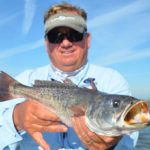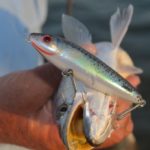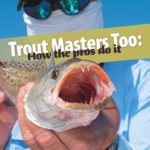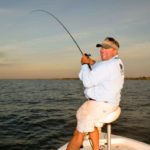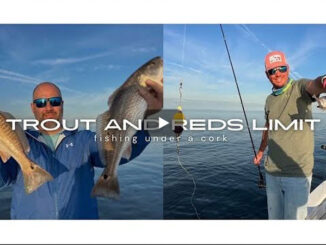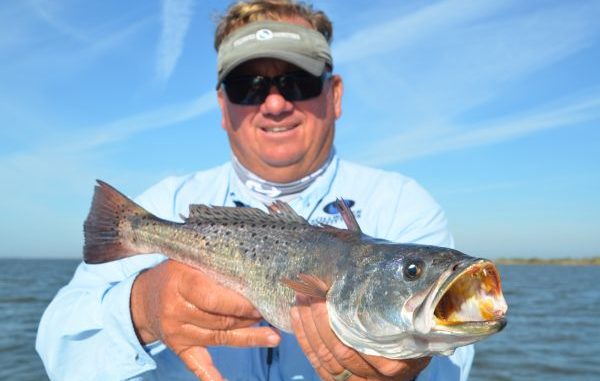
This month the Vermilion Bay will clog with boats full of anglers taking advantage of the annual trout run, but this guide knows where he can catch just as many fish without fighting the crowds.
When it’s cold, it can be hot.
At least that’s what Steve Smith, owner and operator of Stillwater Outfitters (337-654-3880), promised me.
I scrunched my neck down into my collar and tried to inconspicuously hunch myself behind the windshield of his fast bay boat, hoping Smith wouldn’t notice. It was a nippy 13-mile run across Vermilion Bay from Cypremort Point through Southwest Pass off the western end of Marsh Island, followed by another 3 ½ miles in the Gulf to our destination: Tete Butte Reef.
I had spent quite a bit of time with Smith before. He was one of the 14 speckled trout guides featured in my book “Trout Masters Too: How the Pros Do It.” I knew that he was a tough guy and a ferocious competitor.
I knew that, before he became a charter fishing guide in 2009, he raced 700-horsepower sprint cars that ran 140 mph (which made me wonder if he had a death wish) and competed in Iron Man Triathlon competitions (which made me doubt his sanity). Those guys swim 2.4 miles, peddle a bicycle 112 miles and then run 26.2 miles.
Ugh!
We were making the run to Tete Butte Reef for a reason — to get away from the pressure of the crowds. This time of year, from October to December, speckled trout fishing in Vermilion Bay is prime-time stuff. Hotspots in the bay — the Cove, the Hammock, Blue Point, Weeks Bay and the Trash Pile — hold lots of trout.
And those trout attract lots of boats.
“Some days, 75 to 80 boats will be within earshot of each other,” Smith said, “especially at the Cove. It’s kind of a production to go out there (to Tete Butte), but nobody else will be there.
“Trout will be easy pickings off the top of the reef. You’ll see.”
Smith had seduced me by promises of hot topwater speckled trout action, something a little uncommon in December in most places.
“I’ve duck hunted in the morning, and after the hunt, run out here and gotten a limit of trout,” he said matter-of-factly. “The weather just can’t be too bad to run across the bay. The reef is completely sheltered from north winds.”
Indeed, Tete Butte Reef is snugged up to within 200 yards of the Gulf of Mexico shoreline of Paul J. Rainey Wildlife Refuge and Game Preserve.
Smith was on the reef just as the sun peeped its bright-yellow head above the eastern horizon. In the winter, temperature is an important consideration for topwater fishing on the reef, he explained.
“If it is below 55 degrees Fahrenheit, I tend to fish elsewhere early in the morning and then when it warms up come here,” he said.
He spudded down his Power-Pole with the boat positioned to allow him to easily cast through “the gut” and beyond the reef. The gut is his term for the slightly deeper water between the shallows shelving out from the bank toward the reef and the shallows around the reef itself.
Less than a foot of water covered the top of the reef, and Smith explained that much of the reef is completely exposed on low tides.
On the second cast, a modest-sized speck popped his surface lure and immediately got hooked. As he reeled it in, he turned and smirked.
“For me, this is what it’s all about,” Smith said. “It’s the art of deception. You are tricking fish into eating a hard piece of plastic. It’s the ultimate in deception — just a floating stick until you do something with it.”
The stick that he was talking about was a Rapala Skitter Walk in speckled trout color (SW-8). He added that he will also fish MirrOlure She Dogs and Top Dogs, although the latter are a little big for his taste.
Whatever lure he uses will be attached to the leader with a tiny loop knot to allow maximum lure action. His leaders, he explained are always fluorocarbon — not so much because monofilament is more visible but because fluorocarbon is neutrally buoyant and doesn’t affect lure presentation.
He starts with 5-foot leaders in 20-pound test and reties often. When the leader gets to 3 feet or so long, he discards it and ties on another one. The reel’s main line is 15- to 40-pound-test braided line.
The rising sun revealed really poor water clarity — what could, at best, be called dingy. With that and a pretty decent surface chop, it was amazing that he was catching fish, but catching them he was. Every cast produced one or more strikes, and most often a hook-up.
He worked the lure in walk-the-dog fashion. Walk, walk, walk, stop; walk, walk, walk, stop. The hits usually came on the stop.
“I think they find it easier prey when it stops,” Smith said.
With the rising sun, another problem popped up — this one pretty serious. Sea gulls — lots and lots of sea gulls — actually royal terns and laughing gulls to be exact. At first, Smith considered them annoying amusement. They would hover over the working lure and peck at it occasionally.
But he was still catching fish, not as big as he would have liked, but lots of fish. He said one of the reasons he likes to fish, besides getting away from the crowds, is that he feels he has a better chance to catch big specks than on the inside in Vermilion Bay.
This and the other outside reefs have given up legitimate 7-pounders to him.
But the gulls became bolder, and Smith became more vocal. The birds would pick up the lure in their bills and fly 20 or 30 yards before dropping it, usually out of the strike zone of the fish.
“Shoo! Shoo! Scat! Get out of here!” the angler yelled.
Between casts, strikes and yelling at the birds, Smith explained his philosophy on lure color.
“I think that color makes little difference in topwaters,” he said. “When they are in a feeding mode, they eat. You will never hear me say that I throw only one color. It’s not that I’m not selective; it’s that I believe it really doesn’t matter.
“It’s more about presentation than color — and the confidence of the fisherman.”
The birds became even more aggressive. And Smith yelled at them more.
“Ahh! Did you see that? I had a huge blow-up, and the gull grabbed the bait away from the fish before it could hit it again!” he lamented.
The gulls were arousing the competitive nature of an already competitive man. This is a guy who, with partner John Garrison, made up the 2013 Team of the Year in the Louisiana Saltwater Series redfish competition.
“I like the competition; I like the fun” he said in the understatement of the decade.
Smith likes bigger, faster and longer. Earlier in the morning he palmed his Shimano Curado 200 G7 casting reel.
“I souped it up,” he said proudly. “I replaced the stock bearings with ceramic bearings. You know what that’s good for?”
“Yeah,” I answered, remembering that he used braided line, “awesome backlashes”
“No, no, no,” he belly-laughed, “Ten or 15 more yards (on a cast).”
I had to admit, he could cast the Skitter Walk out of sight.
But back to the birds.
It had gotten beyond annoying and beyond comical. It was ridiculous. The gulls were competing to dive bomb the lure on the water. They were grabbing it out of the air before it could even hit the water. They were trying to grab the plug out of the mouth of the flying flock mate that had it at the moment.
“The fish are there,” Smith groused. “I just can’t keep the lure in the water long enough for a fish to get it.”
So he pulled up his Power-Pole and moved, but the birds followed.
“Let’s go inside and see what we can find,” he said with resignation.
When we got to the Cove, 50 boats were stacked there, anchored, trolling and drifting. He turned and leveled his gaze on me.
I knew what he was thinking: “We were the only boat on the reef outside.”
And we had a nice box of fish.
